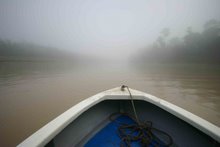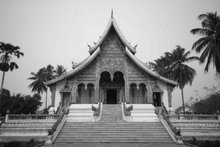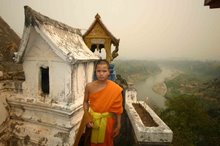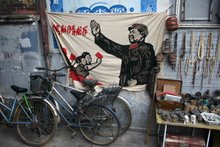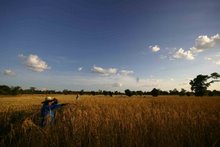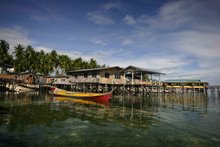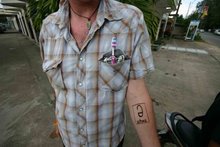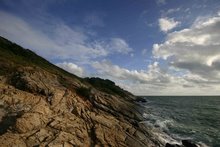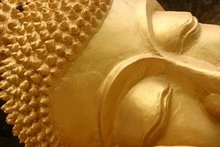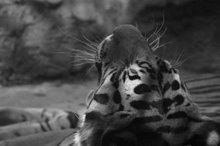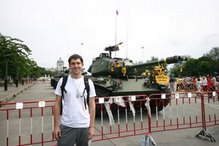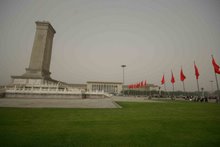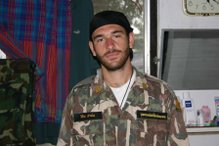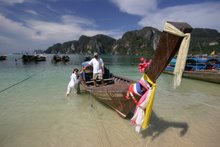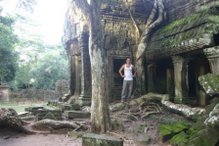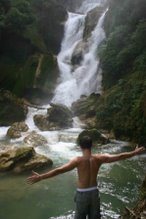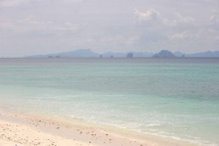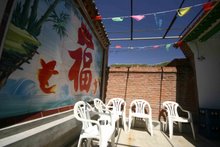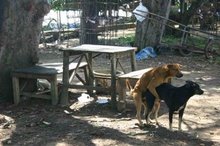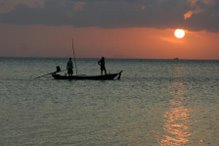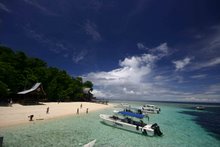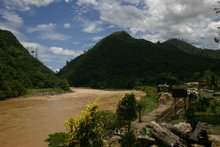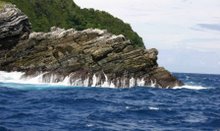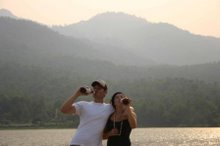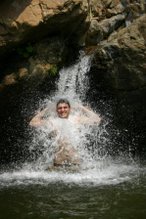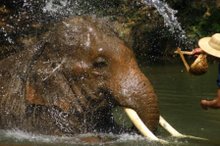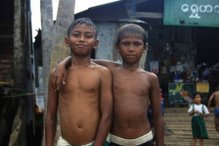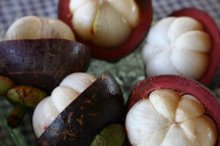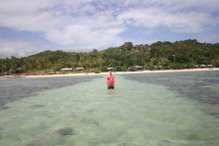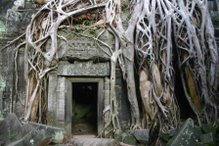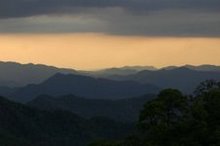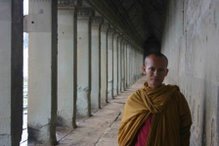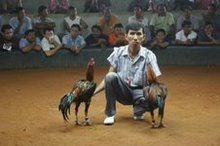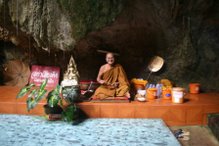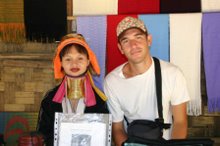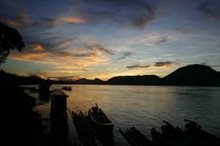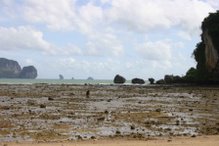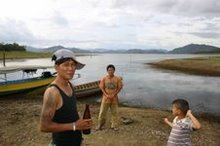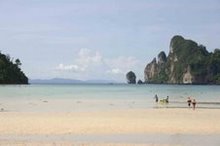At 6 degrees latitude, it was the closest I've ever been to the equator, but standing at 4,095 meters above sea level atop Mt. Kinabalu, it was the coldest I've ever been in South East Asia. Having finished the two-day's climb to the top around 5:00 am, there was little more to do than sit and wait for the sun to rise. Resting, looking off into the dark distance, soon I was shivering cold rubbing my thin gloves together trying to keep my fingers warm. I couldn't do the same for my toes, of which I had already lost all feeling. On the way up in the pitch black of 3:00 am, I followed a single white rope with my headlamp up the last 2 kilometers of the hike. Slowled to a crawl's pace, in the final 100 meters of boulders that made up Low's Peak I was reduced to climbing over individual rocks with hands and feet, one at a time.
On the way up in the pitch black of 3:00 am, I followed a single white rope with my headlamp up the last 2 kilometers of the hike. Slowled to a crawl's pace, in the final 100 meters of boulders that made up Low's Peak I was reduced to climbing over individual rocks with hands and feet, one at a time.
On the top as the sun finall began to rise, the 360 degree view of the world around me ever so slowly became illuminated and, eventually, I could see more than the thousands of stars in the sky, the faint lights of Kota Kinabalu in the far distance below, the slowly moving lights of the climbers still making there way to the top, or the short distance my headlamp lit in front of my eyes.
 As the orange in the distance grew and I could finally see where I was -on top of a mountain, the highest place for hundreds of miles- for the first time in the hike I felt scared of heights. Just below me, to the west was a long drop falling into jagged shards of the mountain. To the south were other peaks, lower but steep and rugged, impossible to climb. To the east was a sloping grade of sharp boulders leading to a drop off into a deep abyss of a valley. Down there the mountains looked like wrinkles in the earth and it was hard to tell if the whites wisps were clouds or lakes below. The north was where we had climbed and suddenly the prospect of going back down the same way was worrisome, now that I could see where I was going.
As the orange in the distance grew and I could finally see where I was -on top of a mountain, the highest place for hundreds of miles- for the first time in the hike I felt scared of heights. Just below me, to the west was a long drop falling into jagged shards of the mountain. To the south were other peaks, lower but steep and rugged, impossible to climb. To the east was a sloping grade of sharp boulders leading to a drop off into a deep abyss of a valley. Down there the mountains looked like wrinkles in the earth and it was hard to tell if the whites wisps were clouds or lakes below. The north was where we had climbed and suddenly the prospect of going back down the same way was worrisome, now that I could see where I was going.
 I can't possibly describe how incredibly beautiful it was up there, and though these pictures show what it looked like, they lack perspective and a depth of field that I enjoyed with my own eyes. They also lack the icy chill of the wind that I could not hide from, the fresh but cruelly thin air that I inhaled in deep breathes, the soreness in every muscle of my legs, and, most importantly, the exhilaration I felt from finally reaching the top of the mountain that had been looming over me since arriving in Borneo.
I can't possibly describe how incredibly beautiful it was up there, and though these pictures show what it looked like, they lack perspective and a depth of field that I enjoyed with my own eyes. They also lack the icy chill of the wind that I could not hide from, the fresh but cruelly thin air that I inhaled in deep breathes, the soreness in every muscle of my legs, and, most importantly, the exhilaration I felt from finally reaching the top of the mountain that had been looming over me since arriving in Borneo.
 The wind whipped but the peak seemed to exist above and excluded from, all weather. Though only half as high as Mt. Everest I felt, quite literally, on top of the world. The ocean I flew over days before seemed impossibly far away. The mountains the mini bus had difficulty climbing along a hectic road to the base camp were reduced to tiny hills. The clouds in the distance slowly floated near the mountain and as they reached nearby mountain tops, they flowed over the peaks spilling into a newly formed ocean of fog. They moved quickly, like time-elapsed video, showing a similarity between sea and sky.
The wind whipped but the peak seemed to exist above and excluded from, all weather. Though only half as high as Mt. Everest I felt, quite literally, on top of the world. The ocean I flew over days before seemed impossibly far away. The mountains the mini bus had difficulty climbing along a hectic road to the base camp were reduced to tiny hills. The clouds in the distance slowly floated near the mountain and as they reached nearby mountain tops, they flowed over the peaks spilling into a newly formed ocean of fog. They moved quickly, like time-elapsed video, showing a similarity between sea and sky.

 I was relieved of my fear of heights climbing back down the mountain, realizing that taking it slowly there were few immediate steep cliffs. It was only in the distance that the mountain appeared to drop off into nothing. Having climbed down the the very top I was able to get my first glimpse of Low's Peak from just below. The photo below is of Low's Peak. Don't jump to conclusions about its accessibility until you look closely: follow the thin white rope from the bottom-left of the photo up to where there are climbers reduced to small bits of color against the huge backdrop.
I was relieved of my fear of heights climbing back down the mountain, realizing that taking it slowly there were few immediate steep cliffs. It was only in the distance that the mountain appeared to drop off into nothing. Having climbed down the the very top I was able to get my first glimpse of Low's Peak from just below. The photo below is of Low's Peak. Don't jump to conclusions about its accessibility until you look closely: follow the thin white rope from the bottom-left of the photo up to where there are climbers reduced to small bits of color against the huge backdrop.
BACK TO THE BEGINNING: Base Camp to Laban Rata
 On the eve of the hike we spent the night at the Rock Hostel at the Base Camp of Mt. Kinabalu National Park. Of note were the extremely friendly and surprisingly beautiful all female staff of park rangers, dressed in skirts and shirts so tight it was obvious they spent no time hiking the trails around the office. That night I attended a briefing about climbing the park and packed my bag carefully, intending to pack only exactly what I needed for the hike so as to not carry up extra weight for no reason at all.
On the eve of the hike we spent the night at the Rock Hostel at the Base Camp of Mt. Kinabalu National Park. Of note were the extremely friendly and surprisingly beautiful all female staff of park rangers, dressed in skirts and shirts so tight it was obvious they spent no time hiking the trails around the office. That night I attended a briefing about climbing the park and packed my bag carefully, intending to pack only exactly what I needed for the hike so as to not carry up extra weight for no reason at all.
I started my climb at 8:00 am the next morning. I hiked it with some friends I had met the previous days, a Scottish girl, an Irishman and an Englishman. It was an endless upward hike. Despite some wooden stairways, hand rails, and rocks positioned as ideal footings, the hike was difficult given my physical shape. The altitude didn't help. At the the first check point we only made a small stop and felt optimistic we had conquered the first kilometer with only a healthy increase in heart rate. But the first leg was by far the easiest. The trail steepened and we began to notice the rare flat stretches in the trail. I felt like I was floating over these as I could walk them without looking down for good footings and instead gazed around at the jungle while my feet moved on autopilot.
 In the middle of the hike we hit a groove, helped along by any silly word games we could think up. We played games naming all the countries beginning with A, then B, then C. We told every joke we could think of. We took turns making up shorts stories. These games kept our mind off our muscles and we hiked up into the clouds without realizing we were tired at all.
In the middle of the hike we hit a groove, helped along by any silly word games we could think up. We played games naming all the countries beginning with A, then B, then C. We told every joke we could think of. We took turns making up shorts stories. These games kept our mind off our muscles and we hiked up into the clouds without realizing we were tired at all.
For a long stretch we hiked in the clouds. We could only see the trail ahead, the forest around us was amidst a dense white fog. At rest points offering benches to sit and rest our legs we stopped briefly to snack and catch our breath. We enjoyed these breaks but made sure not to loose our sweat or let our legs stiffen up.
 The landscape grew rockier and the trees grew shorter and more rare. Fatigue started to weigh on us and we began to walk slower and slower, breathing heavier and heavier. But the clouds began to break and we started to catch distant glimpses of the mountain top that excited us beyond exhaustion and we kept moving, albeit at a much slower pace, stopping more often but only long enough to snap a couple photos and continue on.
The landscape grew rockier and the trees grew shorter and more rare. Fatigue started to weigh on us and we began to walk slower and slower, breathing heavier and heavier. But the clouds began to break and we started to catch distant glimpses of the mountain top that excited us beyond exhaustion and we kept moving, albeit at a much slower pace, stopping more often but only long enough to snap a couple photos and continue on.
The tops of the clouds traveled so quickly over and around us that by the time we would notice the peaks were exposed and managed to get our cameras out, the clouds would already have rolled back over hiding it from view. Without a doubt we were tired, but when we first saw the large yellow-roofed, white building we were again energized by reaching our day’s resting point and marveled that we had made it with so much energy left.
LABAN RATA
 Our resting place for the night, the Laban Rata is a sturdy hostel of paper-thin walls, an all-too small back porch, and an expensive, but good restaurant. We were the second group to reach there that day. We didn’t take long to throw down our bags, untie our shoes, collapse into a chair and start devouring our late lunches.
Our resting place for the night, the Laban Rata is a sturdy hostel of paper-thin walls, an all-too small back porch, and an expensive, but good restaurant. We were the second group to reach there that day. We didn’t take long to throw down our bags, untie our shoes, collapse into a chair and start devouring our late lunches.
Fellow hikers slowly trickled in, each equally excited about reaching the stopping point, happy to sit in a chair, eat a hot meal and take a cold shower. Grabbing a table amidst the limited seating of the back porch we watched the clouds roll and sun pass behind the mountains teacing each other card games to pass the time.
 Some locals took to playing takra on one of the coolest playing fields I’ve ever seen. It looked as though a ball kicked hard enough would land atop the fluffy white clouds. The guys played without notice of the views behind them and when the ball did soar off the playing field, someone would follow it off the edge and out of vision but never returned empty handed.
Some locals took to playing takra on one of the coolest playing fields I’ve ever seen. It looked as though a ball kicked hard enough would land atop the fluffy white clouds. The guys played without notice of the views behind them and when the ball did soar off the playing field, someone would follow it off the edge and out of vision but never returned empty handed.
 Exhausted mentally and physically I went to be a 6:00 pm, expecting to wake up at 2:30 am to start the final ascent by 3:00 am. It took no more than a couple seconds to fall asleep but I awoke in the middle of the night to complete darkness and no way to check the time. I knew it wasn’t near 2:30 yet, but couldn’t be sure. I did nothing. I laid awake for an unknown amount of time in a room so dark I could hardly tell if my eyes were open or shut. I don’t know how long I lied there awake, but I felt content knowing my legs were getting a break even if I wasn't asleep. Eventually the alarm went off and someone turned on the lights. As I layered myself in every article of clothing I brought, we realized that we had all been awake for the past hour or so, lying silently in the dark.
Exhausted mentally and physically I went to be a 6:00 pm, expecting to wake up at 2:30 am to start the final ascent by 3:00 am. It took no more than a couple seconds to fall asleep but I awoke in the middle of the night to complete darkness and no way to check the time. I knew it wasn’t near 2:30 yet, but couldn’t be sure. I did nothing. I laid awake for an unknown amount of time in a room so dark I could hardly tell if my eyes were open or shut. I don’t know how long I lied there awake, but I felt content knowing my legs were getting a break even if I wasn't asleep. Eventually the alarm went off and someone turned on the lights. As I layered myself in every article of clothing I brought, we realized that we had all been awake for the past hour or so, lying silently in the dark.
THE FINAL CLIMB: Laban Rata to Low’s Peak
The morning’s hike was the best part of all. Our bags were light since we were wearing all the clothes and had eated all the food we brought. Headlamps on, we started up the cold, wet rocks as scheduled at 3:00. It was fun. We continued with our silly word games and cruised past other hikers who had begun earlier. The air was much colder but we stopped and took off some layers. The air was thinner but we were refreshed by a good night’s sleep and the closer we got, the more excited we became. Slippery wooden stairs gave way to wet rock and then we came to the white rope.
Lying on the the ground, the white rope lead us the rest of the way up to the top. At some points the incline was so steep that we had to use it to climb up a rock face, but for most the time we walked alongside it up the slope. When we stopped for short breaks we turned off our headlamps to get a better look at the masses stars hanging in the sky. Below us a dim lights of other hikers dotted the line back to the Laban Rata.
There were no longer any trees or any bushes. It was all rock. We pushed ahead with very little way to monitor our progress. Meter markers were few and far between but we stayed faithful to the white rope that lead us slowly creeping up the rock. There were no signs of daybreak. The wind picked up and flew freely across the flat sides of the mountain. The air getting even colder, we stopped and put back on any layers we had taken off.
 Eventually the smooth rock gave way to a tall, immense stack of boulders. The white rope fell between the jagged edges and we followed it up. Employing our hands to help us on the difficult way upwards, we started to rest every minute or so. It was a relief to use our hands; it felt like we were given our legs a rest. The rope fell between rocks where we could not follow and each of us found our own ways up around the rocks. Then, without warning, we came to two small metal signs, one black and written in Malay, and one green and written in English, congratulating us on having reached 4,095 meters, at Low’s Peak.
Eventually the smooth rock gave way to a tall, immense stack of boulders. The white rope fell between the jagged edges and we followed it up. Employing our hands to help us on the difficult way upwards, we started to rest every minute or so. It was a relief to use our hands; it felt like we were given our legs a rest. The rope fell between rocks where we could not follow and each of us found our own ways up around the rocks. Then, without warning, we came to two small metal signs, one black and written in Malay, and one green and written in English, congratulating us on having reached 4,095 meters, at Low’s Peak.
THE LONG WAY BACK: Low’s Peak to Base Camp 
For the first time in my life, it felt like it took longer on the way back than on the way there. We hiked back down the entire way that morning, using different leg muscles than we had used on the way up. Soon my knees were feeling each step. The initial descent was great because it offered spectacular views we had missed climbing in the dark on the way up. The slope was never bad but in the distance the drop off always looked like a long way down.
We learned that we hadn’t needed to follow the white rope so closely. On the way down we strayed far from the rope to peer down valleys, get angles for pictures or just to zig-zag our path in an attempt to rest our quads and calves.
 The clouds seemed miles and miles away for a long time, but we eventually made it closer and closer to them. This allowed us better views down to the smaller, green mountains below but eventually we arrived back to the cloud level, just below Laban Rata. Then we were forced to endure the -then- boring hike through the clouds that gave no breath-taking views and offered no rest from the endless steps downward.
The clouds seemed miles and miles away for a long time, but we eventually made it closer and closer to them. This allowed us better views down to the smaller, green mountains below but eventually we arrived back to the cloud level, just below Laban Rata. Then we were forced to endure the -then- boring hike through the clouds that gave no breath-taking views and offered no rest from the endless steps downward.
I was amazed we had hiked so far up. The path down seemed twice as long. My body weight grew heavier and I could particularly feel it in my knees in every step down. It was then our turn to wish good luck to the hikers making their way up to the top, but we soon became bored with this and as we saw people coming our way we started to recount fictitious tales of nearly fatal accidents that had occurred at the top. I can't believe we saw a bear and it went crazy, chasing after that man! Could you believe how far that guy fell? He bounced off the rocks like a rag doll!
The end came and not a minute too soon. We crashed down onto the pavement back at the base camp, worn to the bone. It was a incredible relief to not have to walk another step. There I got my certificate stating that on April 23rd, 2007, I, Dustin Thomas Johnston, had climbed Mt. Kinabalu.
 Walking around town with my camera hanging around my neck, several groups of people asked me to take their picture. Some of them spoke English and we talked for a bit, others, for whatever reason, just wanted their picture taken. Here's some of them:
Walking around town with my camera hanging around my neck, several groups of people asked me to take their picture. Some of them spoke English and we talked for a bit, others, for whatever reason, just wanted their picture taken. Here's some of them: These punks put a lot of effort into the hagard clothes, odd hairdos, and extreme piercings. My favorite: the kid in the white's cut umbrella.
These punks put a lot of effort into the hagard clothes, odd hairdos, and extreme piercings. My favorite: the kid in the white's cut umbrella.  These two ladies worked a tiny restaurant where I had lunch. They also took pictures of me with their camera phones. When I paid, they asked if I could pay them in a single dollar bill instead of 3 Malaysian Ringgit.
These two ladies worked a tiny restaurant where I had lunch. They also took pictures of me with their camera phones. When I paid, they asked if I could pay them in a single dollar bill instead of 3 Malaysian Ringgit.  These Malaysian dudes stopped me walking down the street just to pose for a pic. No English, nothing other than "photo! photo!" They posed and were on their way.
These Malaysian dudes stopped me walking down the street just to pose for a pic. No English, nothing other than "photo! photo!" They posed and were on their way.  The back pocket of my shorts had a hole big enough that my wallet would fall out of it. This set up his sewing business on the sidewalk and fixed my pocket in a matter of minutes for 1 RM.
The back pocket of my shorts had a hole big enough that my wallet would fall out of it. This set up his sewing business on the sidewalk and fixed my pocket in a matter of minutes for 1 RM.  These are fisherman's kids who, when I walked by, were fishing a watermelon out of the filthy water of the Sandakan harbor. These kids loved the camera and loved to see their picture on the display after I took the shots.
These are fisherman's kids who, when I walked by, were fishing a watermelon out of the filthy water of the Sandakan harbor. These kids loved the camera and loved to see their picture on the display after I took the shots.










































